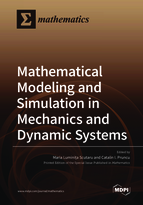Mathematical Modeling and Simulation in Mechanics and Dynamic Systems
A special issue of Mathematics (ISSN 2227-7390). This special issue belongs to the section "C2: Dynamical Systems".
Deadline for manuscript submissions: closed (30 December 2021) | Viewed by 57323
Special Issue Editors
Interests: dynamic and multibody systems; computational mechanics; machine learning in mechanical engineering; mechanics of composite materials; advanced materials modelling and simulation
Special Issues, Collections and Topics in MDPI journals
Interests: numerical simulation; contact mechanics; engineering systems
Special Issues, Collections and Topics in MDPI journals
Special Issue Information
Dear Colleagues,
Although it is considered that in the field of mechanics it is difficult to make further contributions, the spectacular evolution of technology and numerical calculation techniques have made these opinions to be reconsidered and to develop more and more sophisticated models, which should surprise, as accurately as possible, the phenomena that take place in dynamic systems. Therefore, the researchers have come to study mechanical systems with complicated behavior, observed in experiments and in computer models. The key requirement is that the system involves a nonlinearity. The impetus in mechanics and dynamical systems has come from many sources: computer simulation, experimental science, mathematics, and modeling. There are a wide range of influences. Computer experiments change the way in which we analyze these systems.
Topics of interest include, but are not limited to, modeling mechanical systems, new methods in dynamic systems, behavior simulation of a mechanical system, nonlinear systems, multibody systems with elastic elements, multi-degrees of freedom, mechanical systems, experimental modal analysis, and mechanics of materials.
Prof. Dr. Maria Luminița Scutaru
Dr. Catalin I. Pruncu
Guest Editors
Manuscript Submission Information
Manuscripts should be submitted online at www.mdpi.com by registering and logging in to this website. Once you are registered, click here to go to the submission form. Manuscripts can be submitted until the deadline. All submissions that pass pre-check are peer-reviewed. Accepted papers will be published continuously in the journal (as soon as accepted) and will be listed together on the special issue website. Research articles, review articles as well as short communications are invited. For planned papers, a title and short abstract (about 100 words) can be sent to the Editorial Office for announcement on this website.
Submitted manuscripts should not have been published previously, nor be under consideration for publication elsewhere (except conference proceedings papers). All manuscripts are thoroughly refereed through a single-blind peer-review process. A guide for authors and other relevant information for submission of manuscripts is available on the Instructions for Authors page. Mathematics is an international peer-reviewed open access semimonthly journal published by MDPI.
Please visit the Instructions for Authors page before submitting a manuscript. The Article Processing Charge (APC) for publication in this open access journal is 2600 CHF (Swiss Francs). Submitted papers should be well formatted and use good English. Authors may use MDPI's English editing service prior to publication or during author revisions.
Keywords
- dynamic systems
- modelling of nonlinearities
- algorithm
- computer simulation
- finite elements method
Benefits of Publishing in a Special Issue
- Ease of navigation: Grouping papers by topic helps scholars navigate broad scope journals more efficiently.
- Greater discoverability: Special Issues support the reach and impact of scientific research. Articles in Special Issues are more discoverable and cited more frequently.
- Expansion of research network: Special Issues facilitate connections among authors, fostering scientific collaborations.
- External promotion: Articles in Special Issues are often promoted through the journal's social media, increasing their visibility.
- Reprint: MDPI Books provides the opportunity to republish successful Special Issues in book format, both online and in print.
Further information on MDPI's Special Issue policies can be found here.







